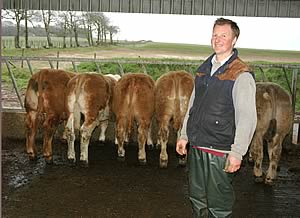27/03/08
Influencing market price is out of the majority of beef producers’ reach,
however they do have tools to hand to reduce costs and improve
their unit’s efficiency and ultimately its sustainability
in the run up to 2012.
Iain Campbell
 |
Iain Campbell is among those who knows first hand that introducing
homebred high genetic merit bulls to his 100 cow suckler herd is
improving its calves’ performance, and ultimately their profitability.
“We use Charolais bulls bred from genetics that we very carefully
select from within the breed’s top 10% using Estimated Breeding
Values. While there maybe some cynics around who dispute the data,
I believe it really does work in providing a back up to a bull’s
looks. The figures offer an accurate indication of what to expect
from his calves,” he says.
“For example, we’re currently finishing virtually all
our steers and heifers to 600kgs target liveweight within 18 months
and trade them through the ring at C&D Dumfries to repeat buyers,
apart from a handful we pick out for the spring continental cross
calf show at Borderway Mart,” Iain said.
“However, we’re aware that our Charolais crosses have
the genetic potential to grow even faster earlier and we plan to
finish our next crop of calves to the same weight from 14 months.
“A beast’s performance efficiency reduces as it gets
older, heavier, and fatter, and its feed conversion ratio falls.
So we plan to start creep feeding our spring born calves three to
four months before we wean them while that performance efficiency
is at its best, and we have the accommodation to house them from
early October.
“We’ve worked things out and the figures stack up. Also
the faster we get these calves away, the more grassland we’ll
have for silage, and overall there’ll be less work,” explains
Ian who manages Allerbeck Farm, near Eaglesfield. Lockerbie, and
employs one man to help run the 250 acre mainly grassland unit which
he believes is now stocked to capacity.
In the last four years since Iain was appointed farm manager, the
commercial suckler herd has doubled to 100 cows. Furthermore, the
unit carries the Swalesmoor pedigree Charolais herd which has expanded
three fold to 40 breeding cows and followers, while it also supports
a complementary 70 ewe commercial flock and buys in up to 450 hoggs
to over winter.
Apart from using Estimated Breeding Values for growth rate when selecting
a bull, Calving Ease is also taken to account.
“If we use a bull with a Calving Ease value of average or above,
it really does ensure his calves don’t grow too big inside
the cow; we make sure the cows are fit but not fat, and we don’t
have any calving issues. They calve at 280 days, they’re lively
and soon up and away,” Iain said.
“These calves also have good temperament – they’re
quiet and easy to handle which is really important when I’ve
only got one man to help out.”
Allerbeck’s commercial beef enterprise provides a shop window
for the up and coming pedigree Swalesmoor Charolais herd whose primary
objective is to provide bulls for the suckler sector that consistently
leave high performance profitable calves suited to low management
systems.
“We’re confident from our own experience that Charolais
is the ultimate terminal sire to breed because its finished progeny
can achieve an additional 100kgs liveweight over other same age Continental
crosses fed on exactly the same diet.
“Secondly, by breeding the best of the breed using genetics
from within the top 10%, then we are able to offer bulls that have
the potential to have a real impact with other suckler men’s
herds.”
Swalesmoor’s targets are for bulls to achieve an average 1.6kg
per day within their first 400 days, they have to demonstrate length
and shape and they must be good on their legs.
“We have built the herd with the addition of Blelack and Givendale
lines in an attempt to achieve consistency. We’ve used a lot
of Dingle Hoffmeister across those pedigree cows simply because he
has had the ability to breed consistently not only within our herd,
but across the country and beyond.
“He also has the figures to match, he’s within the breed’s
top 1%.” Three years ago, Swalesmoor invested in Goldies Uppermost,
the supreme Perth champion and days leader at 34,000gns. “He
is a bull within the breed’s top 10% and he’s throwing
those consistent calves with flesh in all the right places,” he
said.
Selecting within the breed’s top bloodlines has accelerated
the herd’s progress, and Iain says that Breedplan, the society’s
new registration and genetic evaluation system service provider is
helping him to select more easily for specific traits.
“We’re currently on target. Our latest crop of performance
recorded young bulls were all within the breed’s top 10%.” Furthermore,
the hard work is paying off. Last month, Swalesmoor offered four
bulls in Perth, each selling to average around the 4,000gns mark,
a figure that reflects the herd’s commercial target.
“Driving down costs and improving efficiency to maintain a
sustainable beef farming business will remain key well into the foreseeable
future,” Iain adds. “We believe we have a solution here
in Charolais, and we can vouch for that fact having tried and successfully
tested the terminal sire on our own unit.”
 Welshpool Charolais in Strong Demand Welshpool Charolais in Strong Demand
 Aberdeen-Angus
Enjoying Mini-Export Boom Aberdeen-Angus
Enjoying Mini-Export Boom
 British
Blonde Cattle Spring Sale at Carlisle 2008 British
Blonde Cattle Spring Sale at Carlisle 2008
| 




